Dredging & Environment
Dredging is a core maritime operation inherently for maintaining of navigable depths or draught in berths, turning basins and approach navigational channels. Each dredging project is unique and has to consider local conditions .
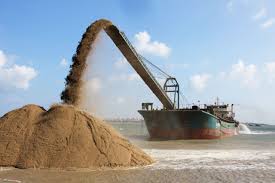 Credit;Ocean14Capital
Credit;Ocean14Capital
Dredging and Environmental Assessment
Environmental dredging activities impact can be mitigated to a certain extent utilising environmentally friendly dredging techniques . Instances are of soft dredged sediments to restore tidal marshes and mudflats as natural riverbank systems, mangroves restoration , promoting biodiversity and enhancing flood resilience . Imposing environmental restrictions on dredging increases costs and a delicate balance should be maintained between economy and environment. Dredging is undertaken for a variety of purposes such as navigation, flood management and environmental enhancement. Dredging and excavation are pivotal in the realm of physical remediation, offering prompt and substantial pollutant reduction through mechanical or hydraulic means . The invasiveness of dredging and excavation disrupts aquatic habitats and anthropegenic life with risks of resuspending fine particles and potentially remobilizing entrapped pollutants . Challenges extend beyond pollutant extraction to include sediment transport and disposal, necessitating careful management to prevent secondary environmental impacts. Innovations include precision dredging and geospatial mapping for accurate contamination zone identification. Advancements in real-time monitoring during dredging operations have enhanced the management of sediment resuspension. Dredging project are earthwork projects which excavate underwater sediments, sand or rocks using specific mechanical equipment to widen and deepen an excavation area. The total capacity of cutter suction dredger has increased by 75 % since the year 2000 to 2.6 million kilowatt in 2010 which is an average increase of 4.3% annually over the last decade . The cutter suction dredger is a widely used and adaptable dredger type. The construction and maintenance of coastal waterways and inland rivers, coastal industrial zones, as well as the development and improvement of coastal cities, water and flood control and environmental protection is viewed in the perspective of cutter suction dredger. Recently, the utilisation of marine resources has been breaching new frontiers such as the marine oil and gas and mining industry, submarine pipelaying , coastal maintenance and iconic marine buildings with heavy reliance on ocean dredging. In the United States of America annually about 250 million cubic yards of sediment are dredged, the actual building material of wetlands and other Nature-based Solutions (NbS) whilst applying the concept of sustainability.
Dredging Worldwide
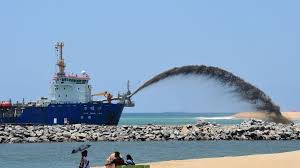 Credit;BBC
Credit;BBC
From the years 2011 to 2016 the total amount of dredging in China increased from 1.7 billion cubic meters to 4.1 billion cubic meters. The Chinese approach is single project contract oriented whereas the European companies pursue a sustainable approach , extending over 15-20 years . According to the International Association of Dredging Companies (IADC) the global dredging market amounted to EUR 10.7 billion in the year 2011. China is the largest dredging market, accounting for almost 29 % of the global dredging market . Other large dredging markets are Europe (13 %), Middle East (11 %) and Latin America (10 %) . The expanding dredging market has sprung fresh opportunities to the dredging industry and raised new technical challenges. Dredger productivity is a crucial factor affecting dredging efficiency, the focus of dredging work.
Marine Strategy Framework for Dredging
Dredging works involving enlarging and deepening access navigational channels, achieving appropriate water depths along waterside facilities are routinely required to carry out maintenance activities in ports all over the world. Fishing harbours , marinas, yatch and sailing clubs and inland waterways have to maintain a minimum level of depth .Maintenance dredging work such as removing accumulated sediments from the bottom of dredged channels is also necessary. During these works possible environmental impacts related to the extraction process take occur. Considering the huge volumes of sediments generated by dredging guidelines developed at the level of national and international policy would guarantee optimal performance of dredging activities. Directives and international regulations are mostly concerned with providing a sustainable use for the sea and marine ecosystems, such as the Marine Strategy Framework Directive and the European Water Framework Directive , which attempted to achieve a good environmental status in all marine waters by 2020. Moreover, the OSPAR Convention ,Barcelona Convention , London LC72 and Helsinki Conventions aim at protecting the marine environment.
Artificial Islands Support Marine Ecosystems
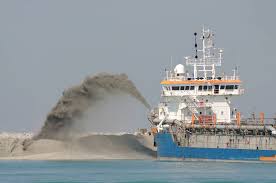 Credit;Acuqread
Credit;Acuqread
Artificial islands have a long history usually constructed by reclamation, which implies building up the island by depositing soil, sand or other construction materials until the water surface is penetrated and an island surface created. To protect such reclaimed artificial islands, protection of the sides of the island by armoring with stone or concrete containment of reclamation material within concrete walls or armored rubble mounds is a technique commonly utilised. In order to improve the footing of the island, foundation improvements by cement hardening of bottom material, sand and structural piling, or sand and gravel foundation carpet placements are used. Such artificial islands have been used as storm barriers, offshore fishing bases, foundations for offshore gun placements for coastal protection and lighthouse foundations since time immemorial. In recent times reclaimed artificial islands came into being as solid waste depositories or fills, sites for toxic industrial activities, nuclear power plants, refineries, marinas and airports such as the mammoth landfill for Kansai Airport in Osaka Bay. The airport is located entirely on an artificial island as its capacity was exhausted and no airport enlargement was possible within the densely built urban space and mounting public opposition against construction on agricultural land . Major alteration through dredging include extensive reclamation of wetlands and shallow nearshore zones, removal of ground elevations and building of artificial islands occupying up to 12 sqkm as in Osaka , Kansai. Rather then reclaiming coastal land and damaging marine ecosystems artificial reefs and islands should be constructed leading to straits and marine passageways to extend operational commercial and economic outreach and stay perched in the territorial waters and exclusive economic zone. These artificial islands would serve as marine strategic, economic and commercial observatories and outposts . Artificial islands creation would serve as vital transshipment , submarine fiber optic internet and bunkering hubs being in the proximity of the international sea routes .
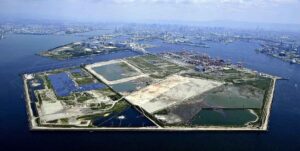 Credit;The Japan Times
Credit;The Japan Times
International Dredging Zones
Dredging Contractors are engaged by ports to restore marine environment and carry out sustainable infrastructure courses.
Internationally the world is divided into dredging zones which monopolize dredging rates including ;
Chinese Dredging Association
Central Dredging Association
Eastern Dredging Association (EADA)
International Association of Dredging Contractors (IADC)
The European Dredging Association (EuDA) members employ approximately 25,000 European employees directly “on land and on board of the vessels” and more than 48,300 people indirectly , through suppliers and services companies. The combined fleet of EuDA’s members is around 750 seaworthy EU-flagged vessels. Being solution oriented European Dredgers are developing and implementing sustainable approaches including “ Building with Nature “ approach , for waterborne transport and energy infrastructures. Not much awareness exists in the public about dredging activities .European dredging companies are world leaders with about 80 % share of the worldwide open dredging market and a turnover of 8.6 billon Euro in the year 2021. Although 70% of operations take place outside Europe invariably 90 % of the returns flow back to Europe. The EuDA assists its members with all kinds of requests related to dredging issues, focusing on Social, Environmental, Technical and Trade issues. These issues are coordinated by the EuDA Secretariat and executed by specialised working groups comprised of experts from the member companies.
Transparency & Maritime Subjugation
EuDA has registered as Interest Representative Nr 2492574893-58 under the EU Transparency Register. The Association pursues its goals by endorsing policies to create fair and equitable conditions for competition, commits to respecting applicable national, European and international rules and regulations, commits to operating its fleet safely, effectively and responsibly. Maritime subjugation can take place at the hands of international dredging associations zone wise. Dredging costs vary from USD $ 3-5 cm (port own assets ) , nationally outsourced at $ 9-12 cm and internationally outsourced $ 12cm hence it is advisable to carry out international third party studies prior to embarking upon any dredging projects . A typical dredger cost is USD $ 150 million and if the crew is national then capital dredging and maintenance dredging should be executed through ports own assets , being cost effective in the medium to long term. Many ports have developed their own human resource and capacity and professional expertise and maintain dredging vessels which result in overall cost savings as maintenance dredging is an ongoing requirement in the navigational channels especially in monsoon zones. Local sedimentation patterns and hydrographic conditions are appreciated by local professionals which ensures operational efficiency and enables rapid response capabilities. Each port has its own characteristics such as tidal movements, strong currents in creeks, estuaries and marine ecosystems which can influence dredging expenditure and it may not be commercially and financially advisable to have an integrated dredging project or combined dredging entity , or pooling of dredging assets (asymmetrical owning of craft) especially where foreign exchange outflow is involved . Pakistan’s Dredging , Piloting and Tugging professionals generally have international Certificates of Competency (CoC) which meet the requirements of IMO and they should be gainfully employed in the national ports and maritime projects .
Global benchmarks ;
a. TSHD: $8-12/m²
b. Backhoe: $10-20/m
C. Bucket: $6-10/m
Mobilisation of foreign dredgers may add $300,000-$1 million per project in Pakistan ( as per |ADC data). International development agencies such as ADB and World Bank-funded projects in Sri Lanka, Bangladesh and Vietnam endorse dredging rates of $10+/m
however frequent delays occur which retard port efficiency and deep draught cargo ship movements and aggravates traffic and cargo congestion at ports.
KPT in 2024 advertised for maintenance dredging of Approach Channel, Tipu Sultan Channel and South Wharf Basin for 16 M depth at Chart Datum for approximately 4.0 Mm3 through deployment of suitable dredging platform (s) /equipment with discharge disposal of discharged material at designated dumping sites at sea approximately 8 km from Fairway. Anticipated completion time was 120 days. A complaint was filed by Van Oord, a global marine contractor, regarding the tendering process for dredging works at Karachi Harbour , as highlighted by Transparency International.
As gleaned from Port Qasim Authority PPRA tenders of 2016-2018 almost 3.0 million cubic meters are to be dredged in the navigational channels and alongside berths and basins which would amount to a staggering USD $ 250 million .
The AGP audit report for fiscal year 2023-24 highlighted financially significant contracts awarded regarding the operation of a locally purchased dredger and the manning, repair and maintenance of the Indus Dolphin dredger . These arrangements appear to contravene Clause 10 (i) of the Merchant Marine Policy 2001, which requires Pakistani-flagged vessels to be crewed by nationals. The policy allows for foreign crew only when suitable Pakistani personnel are unavailable. However, official auditors suggested that PQA may have failed to adequately train or recruit local crew members.
Auditor General Pakistan highlighted that PQA’s expenditure of approximately Rs 6 billion every 5 years since 2015 for the dredger’s operation , nearly four times its purchase price, raised questions on the cost-effectiveness of the current arrangement. Same has been the state of affairs of tugs operations outsourced under contract at PQA . Merchant Marine Policy 2001 (Amended vide Notification dated 15 November 2019) Manning segment emphasises that ships and other floating crafts including tugs, dredgers, survey vessels and other specialised crafts flying the Pakistan flag shall normally be manned by Pakistani nationals. However, in the event where no qualified or suitable Pakistani national is available for any particular job a non-Pakistani national can be employed. Ports however outsource tuggage services and foreign seafarers are employed which is strange as competent and qualified local professionals are available with CoC’s. The indigenous maritime industry is a fledgling one and should be supported and encouraged to adopt Digital Dredging Management Tools and deploying of hydrographic and operational software to improve real-time monitoring and dredging efficiency rather then remain excessively reliant on external experts. Dependency on external contractors for such vital and critical operations can compromise economic and commercial sovereignty and increase exposure to vulnerability during crises .
US Dredging Policy on Environmental Protection
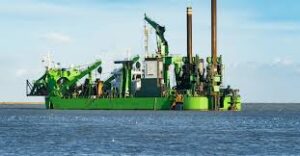 Credit;MarineInsight
Credit;MarineInsight
The US National Dredging Team is a federal interagency group that works to ensure that U.S. harbours, channels and waterways are dredged in a timely and cost-effective manner while environmental protection, restoration and enhancement goals are met. Established in 1995, the National Dredging Team aims to implement the National Dredging Policy, promotes national and regional consistency on dredging issues, provides a mechanism for conflict resolution and facilitates a forum for information exchange among federal, state, and local agencies and marine and environmental stakeholders. The National Dredging Team is co-chaired by Environmental Protection Agency (EPA) and the U.S. Army Corps of Engineers. Member agencies include U.S. Department of Transportation, U.S. Department of Commerce, U.S. Department of the Interior and U.S. Department of Homeland Security. Participating agencies include U.S. Department of Agriculture, U.S. Geological Survey and U.S. Navy.
Dredging Process Flow
Capital works → creation of new or improved facilities, such as harbour basins, deeper navigation channels,– navigation – infrastructure – coastal engineering – mining industry – offshore industry • Maintenance for navigation • Land reclamation • Flood management • Clean up • Drainage and water supply
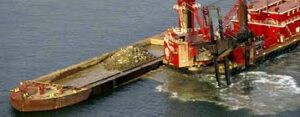 Credit;NOAA
Credit;NOAA
Environmental impacts • (Short-term) effects of the dredging activity: – suspended sediment leading to turbidity; – overflow from hoppers – loss of dredged material during transport (hopper, pipeline); – smothering or loss of benthic fauna at placement site. • Decison-making on dredging needs a site specific assessment to determine if there are unacceptable effects and if they can be sufficiently mitigated or compensated
Mitigation of potential environmental impacts • Improve accuracy – dredging thin layers and reduce dredging volume – improved onboard automation and monitoring • Reduce turbidity • Reduce spill, loss • Minimise dilution, increasing density
By Nadir Mumtaz
Trademark Blue Economy IPO-PK
Credit;
https://share.google/wv92QiPtxzDHjJEOi IADC – International Association of Drilling Contractors
https://share.google/MF0DP3moNtV179zJa 中国港湾
https://www.sciencedirect.com/topics/engineering/dredging ,
https://doi.org/10.1016/j.jclepro.2023.140529 Sciencedirect ,
https://doi.org/10.1016/j.conbuildmat.2009.12.011
https://doi.org/10.1016/B978-1-898563-33-4.50012-4 ,
https://www.sciencedirect.com/topics/earth-and-planetary-sciences/artificial-island , http://doi.org/10.1016/B978-0-12-811951-8.00006-0
http://IADC, Dredging Today.com)
https://pnsc.com.pk/PMMP2001Amended.pdf

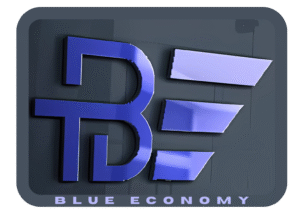
Leave A Comment